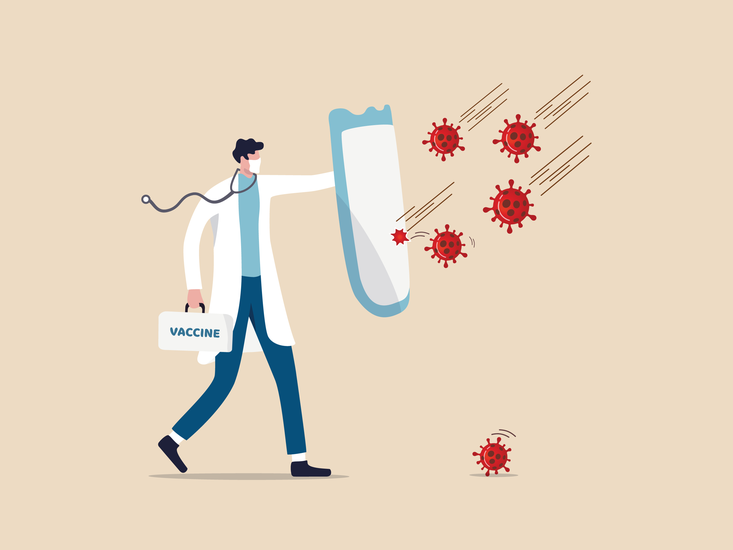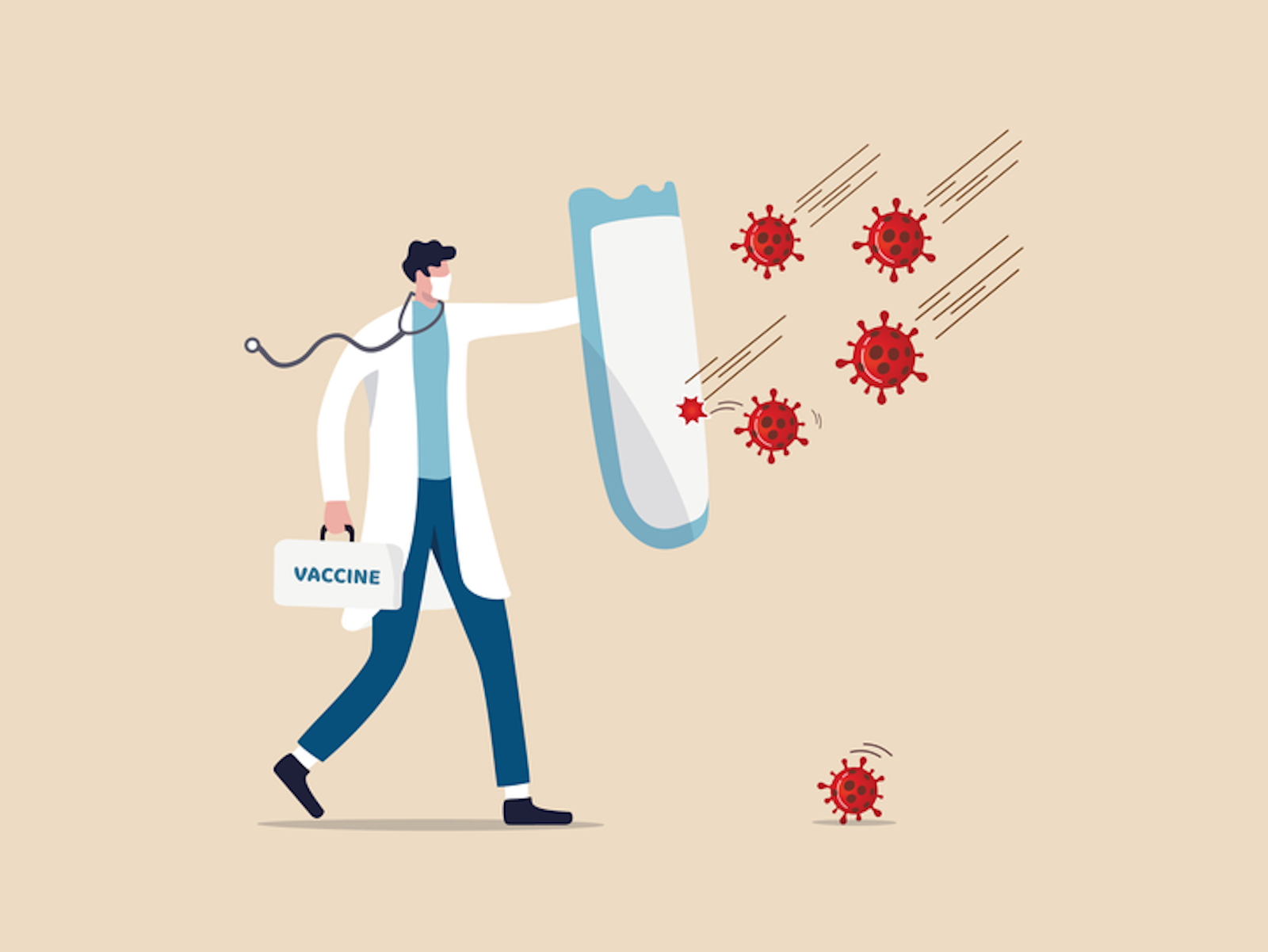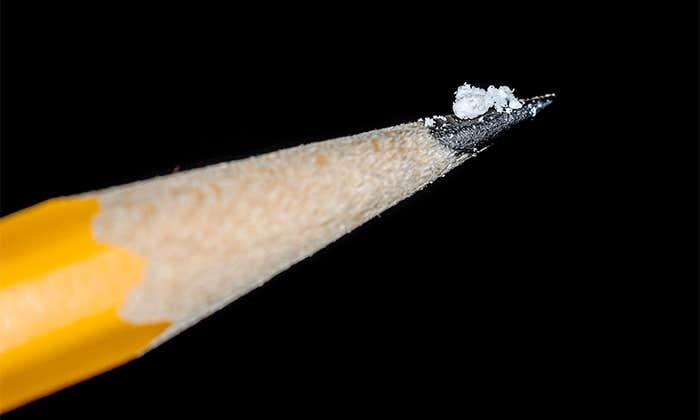
Wayne Koff is one of the world’s experts on vaccine development, the president and CEO of the Human Vaccines Project. He possesses a deep understanding of the opportunities and challenges along the road to a safe and effective vaccine against COVID-19. He has won prestigious awards, published dozens of scientific papers, held major positions in academia, government, industry, and nonprofit organizations. But Koff, 67, has never produced a successful vaccine.
“I have been an abject failure,” he says. He smiles with a charming, self-deprecating sense of humor. “That’s what the message is.”
The real reason for Koff’s lack of success is that he spent most of his career searching for a vaccine against HIV, the virus that causes AIDS. It remains, as he and many others put it, “the perfect storm” of a viral infection resistant to a vaccine development. Almost 40 years after doctors first recognized the disease in five men in Los Angeles—and 70 million people have been infected worldwide—there are no adequate animal models. Neutralizing antibodies, the backbone of many vaccines, do not stop it, and most importantly, HIV begins its assault on the body by attacking CD4 T cells, which serve as the command center of much of the immune system.
As for COVID-19, “We’re all hoping this one is going to be easier,” says Koff, a slight, bearded man with thick, curly salt-and-pepper hair. “There are research issues that still have to be addressed on a COVID vaccine. But they are a lot more straightforward than what we were dealing with in HIV.”
Let’s say we have a vaccine in 18 months. How do you make 1 billion doses or 4 billion doses or whatever it’s going to take to immunize everybody?
Koff and others started the Human Vaccines Project in 2016, modeled on the Human Genome Project. The project works with industry and academia to study the human immune system and develop vaccines, incorporating every modern-day tool, including artificial intelligence, computational biology, and big data sets. Today it is partnered with the Harvard T.H. Chan School of Public Health.
With COVID-19, Koff says, scientists “know the target is the spike protein binding site.” This is where the proteins sticking out from the virus attach to the cells in the human respiratory system. “If you can elicit antibodies against those proteins, they should be neutralizing.” He puts a strong emphasis on should. To prove antibodies will prevent infection, scientists must watch a population of people who’ve been infected for months or longer. It’s a good bet, based on similar viruses, that antibodies will appear and protect—although no one right now can predict how long and how well.
Depending on which count you use, more than 70 companies, universities, and other institutions are offering candidate vaccines. Koff says the real number of companies is lower. During the AIDS crisis, he says, “a lot of people claimed they had an experimental HIV vaccine in development. Some of those were a one-person lab who had created a paper company to attract investors.”
But even with a lower number, almost everyone involved in the search for a vaccine agrees that several different approaches from different research organizations need to proceed in parallel. The world does not have the time to bet on one horse. The race will be neither simple nor cheap.
“The probability of success, depending on whose metric is used in vaccines, is somewhere between 6 and 10 percent of candidate vaccines that make it from the animal model through licensure,” Koff says. “That process costs $1 billion or more. So you can do the math.”
Koff sees big potential problems at the outset. “In the best of all worlds, let’s say we have a vaccine in 18 months. Who knows where the epidemic is going to be then and what its impact is going to be? How do you make 1 billion doses or 4 billion doses or whatever it’s going to take to immunize everybody? Will we need one dose or two or three? These are issues people just haven’t faced before.”
COVID-19 also presents some unique dangers for vaccine safety. Based on how the virus behaves when it infects some people, there’s a chance a vaccine could dangerously overstimulate the immune system, a reaction called immune enhancement. “I’m hoping it’s more theoretical than real,” Koff says. “But that has to be addressed and it may slow down the entire process.” To ensure safety, he says, “It may mean we have to test the vaccine in a larger number of people. It’s one thing to do a 50-person trial in healthy adults as a safety signal. It’s another thing to run a trial of 4,000 or 5000 or more individuals.”
The world does not have the time to bet on one horse. The race will be neither simple nor cheap.
A virus also sometimes causes mysterious, potentially deadly blood clots. This means an experimental vaccine could hypothetically induce the same damage. “This is a bad bug,” Koff says. “We’re just starting to understand that pathogenesis.”
A big question is who should be the first volunteers for widespread vaccine testing. “Who are the high-risk groups?” asks Koff. “Is it nursing-home residents and staff, health-care workers and people on the front lines, or people someplace else like grocery stores? We must also make sure a vaccine is effective for the elderly and people in the developing world.”
Many vaccines work well in young and healthy people but not in older adults because immunity declines with age. Influenza vaccine is a prime example. Rotavirus vaccine, which protects against the deadliest killer—diarrheal disease in children—works better in the developed world. In the developing world, the virus often circulates year-round. Infants get antibodies from breast milk but not enough to prevent disease. Worse, those antibodies can make the vaccine less effective.
Another hypothetical obstacle is that a mutation in the COVID-19 virus could render a vaccine designed today less effective in the future. While the virus mutates frequently, so far there has been little change in the critical part of the spike that binds to human cells.
Of course, neither Koff nor all the others working for a COVID-19 vaccine focus solely on the potential obstacles. At one time, all vaccines against viruses either killed viruses, such as the Salk polio vaccine, or rendered them harmless, such as the Sabin polio vaccine. Now there is a multiplicity of ways to stimulate an immune response to prevent infection or reduce the consequences. These include genetically engineered protein subunits (peptides) or virus-like particles. Such approaches have led to successful vaccines against hepatitis B and human papilloma virus, which causes cervical cancer. Researchers now use “vectors”—harmless viruses attached to the protein subunits and virus particles to transmit them into the body. There are also many new adjuvants, chemicals that boost immune response to a vaccine.
Newer platforms include direct injection of messenger-RNA. M-RNA is the chemical used to translate the information in DNA into proteins in all cells. The Moderna Company, which received a $483 million grant from the U.S. government, and has begun early clinical trials, uses m-RNA to try to make the body produce proteins to protect against the COVID-19 virus. INOVIO Pharmaceuticals uses pieces of DNA called plasmids to achieve the same objective. It has also begun phase 1 studies.
“There are about eight platforms, and it would be good to see a couple vaccines in each of those advance,” Koff says. Predicting which of these most likely to succeed or fail he says would be “simply foolish.”
Many groups, including the Human Vaccines Initiative, are plotting routes to test any possible vaccine more quickly than tradition dictates with an “adaptive trial design.” Usually trials begin with a phase 1 study of some 50 healthy people to search for any immediate signs of toxicity, then moves onto about 200 people in a phase 2, still looking for hazards and a signal of immunity, and then to phase 3 in thousands of people. But the plan here is to start phases 2 and 3 even before its predecessors are finished, and keep recruiting additional volunteers so long as no danger signals arise.
Good animal models are appearing almost daily. Macaque monkeys, hamsters, and genetically engineered mice have all been infected in the laboratory and could determine whether potential vaccines exhibit various types of immunity. Members of Congress from both sides of the aisle have suggested that healthy human volunteers should be allowed to agree to be test subjects, allowing themselves to be infected. Stanley Plotkin, a vaccine researcher at the University of Pennsylvania, was among the first to suggest the idea.
Arthur Caplan, a bioethicist at New York University, says that “deliberately causing disease in humans is normally abhorrent.” But COVID-19 is anything but a normal circumstance. In this case, Caplan says, “asking volunteers to take risks without pressure or coercion is not exploitation but benefitting from altruism.” At least 1,500 people have already volunteered to be such human guinea pigs, although none of the experimental vaccines is far enough along to try such challenging experiments.
Koff says the key to a successful vaccine is a cooperative effort. “It’s going to take a whole different way of thinking to move this onto the expedited train,” he says. “The old dog-eat-dog, ‘I’m going to beat you to the end of the game,’ isn’t going to help us with this.” Seth Berkley, who worked with Koff at the International AIDS Vaccine Initiative, and now heads GAVI, an international vaccine organization, agrees that a COVID-19 vaccine needs a Manhattan Project approach. “An initiative of this scale won’t be easy,” Berkley says. “Extraordinary sharing of information and resources will be critical, including data on the virus, the various vaccine candidates, vaccine adjuvants, cell lines, and manufacturing advances.”
Koff has no regrets about spending so many years on an AIDS vaccine without results. He learned a great deal, he says, which he’s putting to work in the COVID-19 crisis. “The reason COVID-19 vaccines should be a lot easier is because most of the platforms, the novel approaches, and the clinical infrastructure for the testing of vaccines, came out of HIV.” He pauses. “We’re far better prepared.”
Robert Bazell is an adjunct professor of molecular, cellular, and developmental biology at Yale. For 38 years, he was chief science correspondent for NBC News.




























